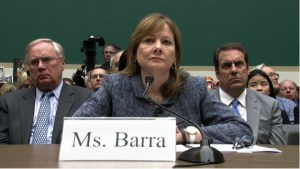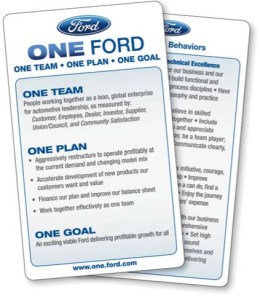|
A number of news stories have recently surfaced on lapses in management judgment of the worst kind: errors of omission and commission that have led to needless deaths. After hearing about the duplicity, cover-ups and lack of oversight at General Motors and the US Veterans Administration, one is tempted to ask how the culture and management mindsets in these organizations evolved to tolerate such egregious behavior? And these are only the latest cases in a long history of corporate misdeeds — e.g. Enron, Lehman, Cendent, HealthSouth, WorldCom — that raise the related question: what were they thinking?! In retrospect, even in the worst cases of fraudulent or reckless behavior, it is probably fair to say that the men and women behaving badly didn’t join a company with the intent to brazenly break the law or endanger innocent lives. More likely, they felt intense pressure to meet performance expectations, in a corporate environment where the downside risks of underperforming were perceived as higher than the likelihood of penalties for inappropriate behaviors. In short, such individuals probably slid into an immoral quagmire with very bad outcomes, one misdeed at a time. Many companies react to the glare of bad publicity by blaming one or two “bad apples” as the cause of their fall from grace. But this explanation is superficial and often masks the root cause: the corporate culture that tolerates, if not fuels employee misdeeds. Can Culture Be Changed? To her credit, General Motors’ CEO Mary Barra has acknowledged shortcomings in GM’s management culture that contributed to its failure to identify a fatal ignition switch design defect. In her testimony before Congress last month, Barra threw the “old GM” under the proverbial bus, citing an historical management mindset which placed cost savings over corporate responsibility. Barra pledged that the “new GM” has already begun to purge the demons of the company’s ignominious past. Eric Shinseki, United States Secretary of Veterans Affairs since 2009 is said to have inherited a “culture of fear” at the Veteran’s Administration. At the VA, some management officials allegedly gamed the system to artificially inflate performance statistics, protected by a corporate Omertà, where potential whistleblowers feared the organization’s longstandinghistory of retaliation. Can such debilitating cultural environments be reformed? The answer is yes, and with deceptive ease under the right circumstances. Yet cultural transformation remains devilishly difficult, where more often, bandaid solutions fail to reverse longstanding incentives and protocols that have promoted (perhaps unwittingly) dysfunctional employee and management behaviors. Take Ford, for example. When William Clay Ford, the fourth-generation family member to run the company, remarkably volunteered to abdicate his position as CEO in 2006 at age 49, the company was in perilous condition. Ford was on the verge of bankruptcy, its product lines were stale and poorly received, its international operations were in shambles, and it suffered poor quality, high costs, lagging technology and unimaginative styling. Ford lost nearly $15 billion in William Clay Ford’s last two years as CEO. Much of the blame could be attributed to Ford’s toxic culture, characterized by fierce turf battles, lack of collaboration and severe fault intolerance, all of which contributed to an unwillingness for executives to acknowledge management challenges or to participate in joint problem-solving efforts. It was not uncommon for example for Ford executives to purposely design cars for their own region in ways that would make them unsuitable for sale in other regions, lest another executive benefit. Shortly after Alan Mullaly (formerly head of Boeing’s commercial airplane division) took over as Ford’s CEO, he started a campaign to reform Ford’s culture. Under the banner “One Ford,” Mullaly instituted weekly Business Plan Review meetings with his direct reports where each executive was expected to assess the status of programs under their watch. Many observers attribute the beginning of the turnaround of Ford’s culture and business fortunes to one such meeting, early in Mullaly’s tenure, when the then head of US automotive operations, Mark Fields gave one of Ford’s new car development programs a red flag, under a Red/Yellow/Green evaluation system Mullaly instituted for his management reviews. As the episode has been retold, Fields’ colleagues were shocked. No one had red flagged a major program to a Ford CEO before (in this case, related to a balky tail gate latch design). Mullaly broke the stunned silence by applauding Fields for his candor and asking whether there was anything the Ford organization as a whole could do to help. This is the deceptively simple side of culture change. At most other organizations, this type of exchange between two senior executives would hardly be worth mentioning. But at Ford, it signaled a sea change in how management would behave and communicate. Honesty was applauded. Collaboration was the new norm. Mullaly consistently reinforced his expectations for a more collaborative culture in every management forum, and further reinforced desired corporate values by changing Ford’s compensation incentives. Before Mullaly arrived, employee bonuses were based entirely on individual and division performance, unwittingly encouraging fierce rivalries between executives in “competing” units. Mullaly instituted new incentives, where individual bonuses were more heavily dependent on overall corporate performance. As a result, Mullaly’s mantra of “One Ford” took on real meaning where it counts most — in employees’ wallets. Over time, the revised management behaviors at the top level of the organization filtered down through the workforce, influencing decision-making at all levels of the organization. After eight years at the helm, Mullaly is leaving Ford in great shape. Ford earned over $42 billion in the last five years. Surging sales of Escape sport-utility vehicles, F-Series pickups and Fusion sedans drove Ford’s U.S. sales up 11 percent last year. In China, the world’s largest car market, Ford now outsells Toyota, and Ford has even begun to see sustained market share gains in its historically weak European business. And, as an enduring testament to the cultural transformation he engineered at Ford, on July 1, Mullaly will turn the CEO reins over to Mark Fields, the first executive to raise a red flag in a Ford performance review meeting. Leadership Styles Time will tell whether the Mary Barra’s “new General Motors” has indeed mended its ways, but the new CEO has a tough job ahead. For one thing, Barra is a 33-year veteran of the old GM, including leadership positions in engineering groups responsible for vehicle design. Barra is very much a creature of the old GM that she now disavows. Moreover, Barra’s ability to forcefully communicate her new vision has undoubtedly been reined in by legal advisors, defending against pending lawsuits and recall actions that may cost the company billions of dollars. At the very time the new CEO needs to communicate with laser-like clarity, and to move with speed and purpose in transforming GM’s hidebound culture, Barra has been deliberate, cautious and slow, prompting a bitingly savage Saturday Night Live parody. One early action Barra did take, was to appoint a new Vice President of Global Vehicle Safety with “responsibility for the safety development of GM vehicle systems, confirmation and validation of safety performance, as well as post-sale safety activities, including recalls.” While on the surface, this appears to be a positive step, it leaves unanswered fundamental questions about whether GM has really addressed its management shortcomings.
As Apple noted at the time, the vast majority of iPhone owners didn’t experience mobile phone reception problems, and for the few that did (allegedly related to how users held their phones) a simple fix was to use a protective rubber bumper which Apple subsequently provided to customers for free. Nonetheless, when news of Apple’s “Antennagate” first broke, Steve Jobs abruptly cancelled one of his rare family vacations and raced back from Hawaii to Apple headquarters to personally lead days of intense management reviews aimed at understanding underlying engineering design issues and determining Apple’s corporate response. Within a couple of weeks, Jobs conducted an extensive press briefing on the causes and cures for Apple’s phone design issues. Less than a month later, Jobs fired Apple’s Senior Vice President of Devices Hardware Engineering. No new organizational entities were created to ensure Apple’s product design integrity. Jobs responded to the product quality issue with speed, decisiveness and action. While it is admittedly unfair to directly compare Barra’s and Jobs’ responses to product design problems, given significant differences in context, the fact still remains that the breadth, speed and authenticity of a CEO’s response to ongoing challenges is perhaps the most significant determinant of an organization’s culture. As such, Steve Jobs clearly left his mark on Apple’s organization and Mary Barra’s leadership impact is still work in progress. What About Your Company? If you are concerned about the health of your company’s culture, there are four leadership essentials that need to be in place to achieve an effective transformation.
Leadership matters.
0 Comments
Your comment will be posted after it is approved.
Leave a Reply. |
Len ShermanAfter 40 years in management consulting and venture capital, I joined the faculty of Columbia Business School, teaching courses in business strategy and corporate entrepreneurship Categories
All
Archives by title
How MIT Dragged Uber Through Public Relations Hell Is Softbank Uber's Savior? Why Can't Uber Make Money? Looking For Growth In All The Wrong Places Three Management Ideas That Need to Die Wells Fargo and the Lobster In the Pot Jumping to the Wrong Conclusions on the AT&T/Time Warner Merger What Kind Of Products Are You Really Selling? What Shakespeare Thinks About Brian Williams Are Customer-Friendly CEO’s Bad for Business? Uncharted Waters: What to Make Of Amazon’s Chronic Lack of Profits What Happens When David Becomes Goliath…Are Large Corporations Destined To Fail? Advice to Publishers: Don’t Fight For Your Honor, Fight For Your Lives! Amazon should be viewed as a fierce competitor in its dispute with publisher Hachette Men (And Women) Behaving Badly Why some brands “just don’t get no respect!” Courage and Faustian Bargains Sun Tzu and the Art of Disrupting Higher Education Nobody Cares What You Think! Product Complexity: Less Can Be More Apple's Product Strategy: No News Is Good News Willful Suspension of Belief In The Book Publishing Industry Whither Higher Education Timing Is Everything Teachable Moments -- The Curious Case of JC Penney What Dogs Can Teach Us About Business Are You Ready For Big-Bang Disruption? When Being Good Isn’t Good Enough Is Apple Losing Its Mojo? Blowing Up Old Habits What Is Apple's Product Strategy--Strategic Rigidity or Enlightened Expansion Strategic Inertia Strategic Alignment Strategic Clarity Archives by date
March 2018
|
Proudly powered by Weebly



 RSS Feed
RSS Feed